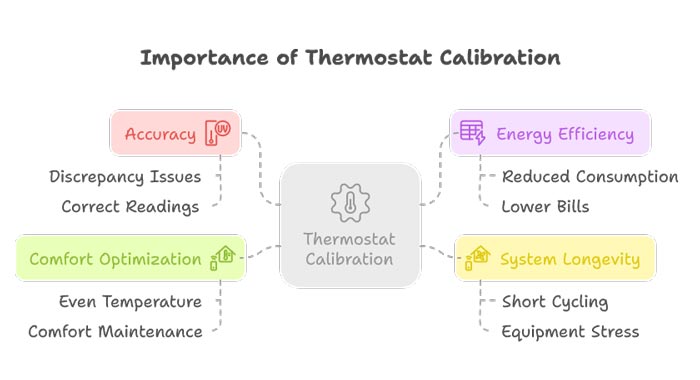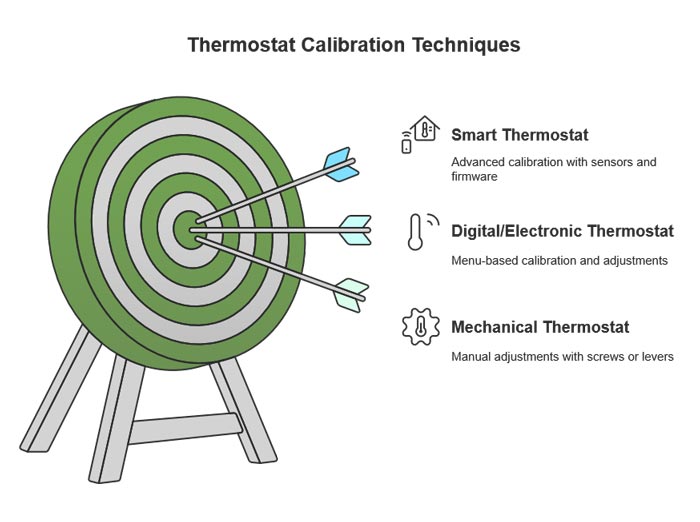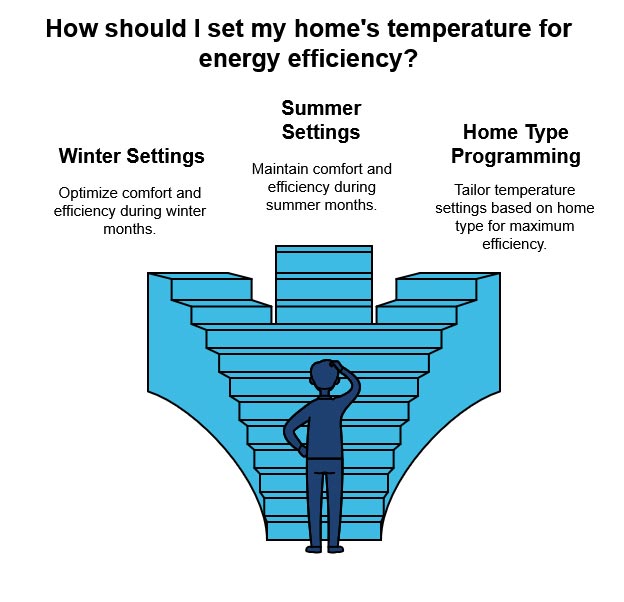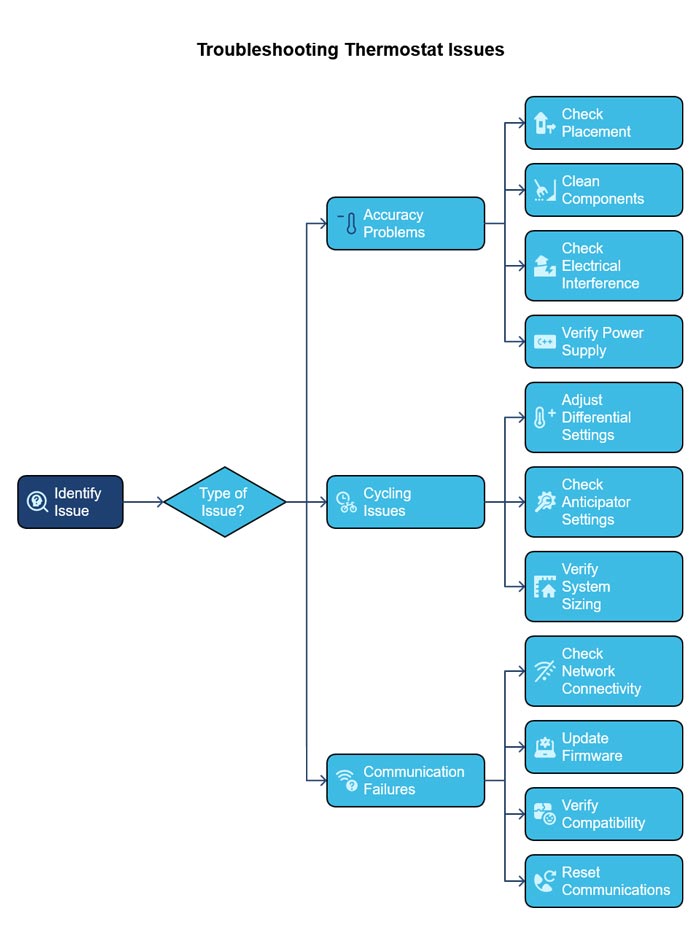In today’s energy-conscious world, proper thermostat calibration and programming are essential for maintaining comfortable indoor environments while minimizing energy consumption. Whether dealing with a simple mechanical thermostat or a sophisticated innovative system, understanding how to properly set up, calibrate, and program your temperature control device can lead to significant energy savings and improved comfort. This article explores the fundamentals of thermostat technology, calibration techniques, programming strategies, and best practices for various HVAC systems.
Understanding Thermostat Technology
Types of Thermostats
Thermostats have evolved dramatically over the decades, from simple bimetallic strip models to sophisticated Wi-Fi-enabled innovative systems. The main categories include:
- Mechanical Thermostats: These traditional devices use physical components like bimetallic coils that expand and contract with temperature changes. While inexpensive and straightforward, they typically offer limited accuracy with temperature swings of 2-5°F around the setpoint.
- Electronic Thermostats: These use electronic sensors rather than mechanical components, providing greater accuracy with temperature swings of 1°F or less.
- Programmable Thermostats: These allow users to set temperature schedules for different times and days of the week, enabling automatic adjustments based on occupancy patterns.
- Smart Thermostats: The most advanced option, these devices connect to WiFi networks, learn from usage patterns, offer remote control via smartphone apps, and can integrate with other smart home systems for optimized performance.
How Thermostats Communicate with HVAC Systems
Thermostats act as the control center for heating, ventilation, and air conditioning (HVAC) systems. When the temperature deviates from the setpoint, the thermostat sends signals to activate the appropriate components of the system:
- When temperatures fall below the setpoint in heating mode, the thermostat completes a circuit that activates the furnace or heat pump.
- When temperatures rise above the setpoint in cooling mode, the thermostat signals the air conditioner to begin operation.
More advanced thermostats can control multi-stage heating and cooling, humidity levels, fan operation, and even communicate with zone control systems for room-by-room temperature management.

Thermostat Calibration Fundamentals
Why Calibration Matters
Thermostat calibration is crucial for several reasons:
- Accuracy: An incorrectly calibrated thermostat may display one temperature while the room temperature differs, leading to discomfort.
- Energy Efficiency: Poor calibration can cause HVAC systems to run longer than necessary, wasting energy and increasing utility bills.
- System Longevity: Improper calibration can cause short cycling (rapid on/off operation) that stresses HVAC equipment and shortens its lifespan.
- Comfort Optimization: Proper calibration ensures that temperature readings accurately reflect ambient conditions, maintaining comfort throughout the space.
Thermostat Calibration and Programming: Maximizing Comfort and Efficiency in Colorado
Proper thermostat calibration and programming are essential in Colorado’s diverse climate zones to maintain comfortable indoor environments while minimizing energy consumption. Colorado residents, from high-altitude mountain towns to the urban Front Range corridor, face unique HVAC challenges requiring thoughtful thermostat management.
Understanding Thermostat Technology for Colorado’s Climate
Types of Thermostats and Colorado Climate Considerations
| Thermostat Type | Cost Range | Features | Best For Colorado Climate Zones |
|---|---|---|---|
| Mechanical | $15-$50 | Essential temperature control, no programming | Budget-conscious homeowners, simple systems |
| Basic Electronic | $40-$120 | Digital display, simple programming | Mid-range homes, basic scheduling needs |
| Programmable | $80-$250 | 7-day programming, vacation mode | Most Colorado homes accommodate variable schedules |
| Smart/Connected | $150-$450 | Remote access, learning capability, and humidity control | High-altitude homes, Front Range with variable temperatures |
| Advanced Smart | $200-$600 | Multi-zone control, geofencing, advanced learning | Large homes, mountain properties with zoning needs |
In Colorado’s unique climate, thermostats face special challenges, including:
- Altitude effects: Higher elevations experience different heating and cooling demands, requiring more precise calibration
- Dramatic temperature swings: Front Range areas can see 30°F+ temperature changes in a single day
- Dry air conditions: Low humidity affects how temperatures feel, making proper calibration more important
- Heating-dominated climate: Most areas prioritize heating performance over cooling
Thermostat Calibration for Colorado’s Regions
Regional Calibration Considerations
| Colorado Region | Special Calibration Needs | Recommended Calibration Frequency |
|---|---|---|
| Front Range (Denver, Boulder, Fort Collins) | Account for Chinook winds, rapid temperature changes | Every 6 months |
| Mountain Communities (Breckenridge, Vail) | Altitude compensation, extreme cold protection | Every 3-4 months |
| Western Slope (Grand Junction) | Higher cooling demands, dust accumulation | Every 6 months |
| Eastern Plains | Wind effects, extreme seasonal variation | Every 6 months |
| Urban Denver Metro | Heat island effects, building density factors | Every 6 months |
Professional Calibration Service Costs in Colorado
| Service Type | Average Cost | What’s Included | Recommended For |
|---|---|---|---|
| Basic Calibration | $75-$125 | Thermostat accuracy check, simple adjustments | All thermostat types |
| Comprehensive Calibration | $125-$200 | System-wide check, airflow testing, thermostat calibration | Homes with comfort issues |
| Smart Thermostat Installation & Calibration | $200-$350 | New thermostat, professional setup, system integration | Upgrading from older models |
| Annual HVAC Service Contract | $150-$300/year | Bi-annual system check including thermostat calibration | All Colorado homes |
Many Colorado HVAC companies include thermostat calibration in their seasonal maintenance packages. Spring and fall are ideal times for service before the heating and cooling seasons.
Programming Strategies for Colorado’s Seasonal Changes
Denver Metro Area Recommended Programming Settings
| Season | Period | Recommended Temperature | Energy Saving Potential |
|---|---|---|---|
| Winter | Morning (6 am-9 am) | 68°F | Baseline |
| Daytime (9 am-5 pm) | 62-65°F (unoccupied) | 5-10% savings | |
| Evening (5 pm-10 pm) | 68-70°F | Baseline | |
| Overnight (10 pm-6 am) | 62-65°F | 5-8% savings | |
| Summer | Morning (6 am-9 am) | 75-76°F | Baseline |
| Daytime (9 am-5 pm) | 78-80°F (unoccupied) | 3-5% savings | |
| Evening (5 pm-10 pm) | 75-78°F | Baseline | |
| Overnight (10 pm-6 am) | 75-78°F | 1-3% savings |
Mountain Communities Programming Settings (Elevation >7,000 ft)
| Season | Period | Recommended Temperature | Energy Saving Potential |
|---|---|---|---|
| Winter | Morning (5 am-8 am) | 66-68°F | Baseline |
| Daytime (8 am-4 pm) | 60-62°F (unoccupied) | 8-12% savings | |
| Evening (4 pm-10 pm) | 66-68°F | Baseline | |
| Overnight (10 pm-5 am) | 58-62°F | 8-10% savings | |
| Summer | Morning (6 am-9 am) | 72-74°F | Baseline |
| Daytime (9 am-5 pm) | 75-78°F (unoccupied) | 2-4% savings | |
| Evening (5 pm-10 pm) | 72-74°F | Baseline | |
| Overnight (10 pm-6 am) | 68-70°F | 3-5% savings |
Note: Mountain communities often require less cooling but more substantial heating adjustments.
Signs Your Thermostat Needs Calibration
Several indicators suggest your thermostat might need calibration:
- Frequent temperature swings or inconsistent heating/cooling
- Actual room temperature differs significantly from the thermostat display
- HVAC system short-cycles (turns on and off in rapid succession)
- Some areas of your home are significantly warmer or cooler than others
- The system runs continuously without reaching the setpoint
- You notice unexpected increases in energy bills
Equipment Needed for Calibration
The calibration process requires specific tools to ensure accuracy:
- Accurate thermometer: An independent, laboratory-grade digital thermometer provides a reliable temperature reference point.
- Small screwdriver set: Necessary for accessing internal components on mechanical thermostats.
- Level: Ensures the thermostat is mounted correctly on the wall (tilted thermostats can give inaccurate readings).
- Compressed air or a soft brush removes dust and debris that might affect sensing components.
- Multimeter: This is used to check electrical connections in electronic models.
Calibration Techniques for Different Thermostat Types
Mechanical Thermostat Calibration
Mechanical thermostats typically have an uncomplicated calibration mechanism:
- Verify the current temperature using an accurate thermometer near the thermostat (but not touching the wall).
- Remove the thermostat cover carefully to access the internal components.
- Locate the calibration screw or lever, usually found near the bimetallic coil or mercury switch.
- Adjust the calibration by turning the screw or moving the lever in small increments. Generally, clockwise rotation increases the reading (makes the thermostat “think” it’s warmer) while counterclockwise decreases it.
- Test and readjust by waiting 15-30 minutes between adjustments to stabilize the system, then compare the thermostat reading to your reference thermometer.
Digital/Electronic Thermostat Calibration
Electronic thermostats often have built-in calibration functions:
- Access the calibration mode through the menu settings (consult your user manual for the specific procedure).
- Enter the actual temperature as measured by your reference thermometer.
- Save the calibration settings according to the manufacturer’s instructions.
- Verify calibration by comparing the adjusted thermostat reading to your reference thermometer after running the system for at least 30 minutes.

Smart Thermostat Calibration
Smart thermostats typically offer more sophisticated calibration options:
- Use the built-in calibration function through the device interface or associated smartphone app.
- Check for automatic calibration features that may continuously adjust readings based on multiple sensors.
- Utilize remote sensors that can be placed in different rooms to create a more accurate temperature profile throughout the home.
- Update firmware regularly to ensure the thermostat benefits from manufacturer improvements to sensing and calibration algorithms.
Professional Thermostat Calibration Services
While DIY calibration is possible for many thermostats, professional services offer advantages:
- Expertise and specialized tools: HVAC technicians can access professional-grade testing equipment and extensive training.
- System-wide assessment: Professionals can evaluate whether calibration issues stem from the thermostat or other HVAC components.
- Warranty preservation: Some HVAC warranties require professional service to remain valid.
- Complex system support: Professional calibration ensures all components work harmoniously for multi-zone systems or advanced commercial installations.
Most HVAC maintenance contracts include thermostat calibration as part of regular service visits, which are typically recommended twice yearly (before the heating and cooling seasons).
Local Utility Programs and Incentives
Colorado Utility Thermostat Rebate Programs
| Utility Company | Program Name | Rebate Amount | Eligible Thermostats | Requirements |
|---|---|---|---|---|
| Xcel Energy | Smart Thermostat Rebate | $50-$75 | ENERGY STAR-certified smart thermostats | Must be an Xcel customer |
| Colorado Springs Utilities | Smart Thermostat Rebate | Up to $50 | Selected models from the approved list | Must be a CSU customer |
| Fort Collins Utilities | Efficiency Works | Up to $50 | ENERGY STAR certified models | Must be serviced by FCU |
| Black Hills Energy | Residential Rebates | $25-$50 | Selected programmable and smart models | BHE natural gas customer |
| Mountain View Electric | Energy Efficiency Rebate | $25 | ENERGY STAR certified models | MVEA customer |
Many Colorado utilities also offer demand response programs that work with smart thermostats. These programs provide bill credits of $25-$50 annually for allowing minor temperature adjustments during peak demand periods.
Colorado HVAC System Considerations
Thermostat Compatibility with Common Colorado HVAC Systems
| HVAC System Type | Prevalence in Colorado | Recommended Thermostat Types | Special Programming Needs |
|---|---|---|---|
| Forced Air Gas Furnace | 65% of homes | All types, brilliantly recommended | Standard seasonal programming |
| Heat Pump | Growing (15%) | Advanced electronic or smart | Heat pump-specific algorithms |
| Hydronic/Radiant | Common in mountain homes | Specialized models with floor sensing | Steady-state programming |
| Evaporative Cooling | Standard on the Western Slope | Models with fan control | Separate fan-only settings |
| Multi-Zone Systems | Common in larger homes | Advanced smart with zone control | Individual zone calibration |
| Dual Fuel Systems | Growing in Front Range | Advanced smart with dual fuel control | Outdoor temperature setting |
Colorado-Specific Installation Considerations
| Installation Factor | Cost Implications | Notes for Colorado Homes |
|---|---|---|
| Standard Installation | $100-$200 | Essential replacement, existing wiring |
| New Wiring Installation | $200-$400 | Older homes need C-wire installation |
| Multi-Zone Installation | $300-$700 | Multiple thermostats, zone control panels |
| Remote Sensor Installation | $50-$100 per sensor | Familiar with mountain homes with temperature variation |
| WiFi Extender (if needed) | $30-$150 | For homes with connectivity challenges |
| Specialized Altitude Adjustments | $75-$150 | For homes above 7,000 feet |
Strategic Thermostat Programming for Maximum Efficiency
Basic Programming Principles
Effective thermostat programming follows several key principles:
- Setback periods: Program lower temperatures (in winter) or higher temperatures (in summer) during periods when the home is unoccupied or when occupants are sleeping.
- Recovery time: Allow sufficient time for the system to reach comfortable temperatures before occupancy periods begin.
- Minimal overrides: Resist the temptation to override programmed settings, which can negate energy savings frequently.
- Seasonal adjustments: Update programming seasonally to accommodate changing weather patterns and occupancy.
Recommended Temperature Settings
Energy authorities typically recommend the following temperature settings for optimal efficiency:
Winter settings:
- 68°F (20°C) when home and awake
- 62-66°F (17-19°C) when asleep or away
Summer settings:
- 78°F (26°C) when home and awake
- 82-85°F (28-29°C) when away
These settings balance comfort with energy efficiency, though individual preferences may vary.
Programming for Different Home Types
Different living situations require tailored programming approaches:
Single-family homes:
- Create schedules based on consistent family routines
- Consider different zones for sleeping and living areas if possible
- Account for weekend vs. weekday patterns

Multi-unit buildings:
- Factor in heat transfer from adjacent units
- Consider the stack effect in taller buildings (warm air rising)
- Adjust for exposure differences (north vs. south-facing units)
Vacation homes:
- Implement deeper setbacks during extended vacancy
- Use remote access to pre-condition the space before arrival
- Consider freeze protection settings in colder climates
Smart Programming Features
Modern smart thermostats offer advanced programming capabilities:
- Learning algorithms: Systems that analyze behavior patterns and automatically create optimal schedules.
- Geofencing: Uses smartphone location to adjust temperatures based on proximity to home.
- Smart recovery: Calculates optimal start times to reach target temperatures by specific times.
- Weather responsiveness: Adjusts operation based on current and forecast weather conditions.
- Occupancy sensing: Detects when people are present and adjusts settings accordingly.
- Integration with other systems: Connects with smart home platforms for coordinated operation with lighting, security, and other home systems.
Optimization Techniques for Specific HVAC Systems
Forced Air Systems
For conventional forced air heating and cooling:
- Fan operation: Program fan-only circulation during moderate weather to improve air mixing and temperature consistency.
- Filter consideration: Recall reduced airflow from dirty filters by scheduling regular replacements.
- Multi-stage operation: For systems with variable capacity, ensure the thermostat properly manages all available stages for maximum efficiency.
Heat Pump Systems
Heat pumps require specialized programming approaches:
- Minimal setbacks: Use more moderate setback temperatures (2-3°F) as heat pumps are less efficient when recovering from significant temperature differences.
- Auxiliary heat management: Program the thermostat to minimize use of auxiliary electric resistance heating, which is significantly less efficient.
- Balance point settings: Configure the switchover to auxiliary heat based on outdoor temperature thresholds (balance points) appropriate for your climate and equipment.
Radiant Heating Systems
In-floor or radiator systems benefit from different programming strategies:
- Longer recovery times: Allow more time for the thermal mass to reach desired temperatures.
- More minor setbacks: Use more moderate temperature reductions due to the slower response time.
- Anticipatory programming: Set recovery to begin well before occupancy periods due to the inherent lag in radiant heating response.
Troubleshooting for Colorado-Specific Issues
Common Problems in the Colorado Climate
| Issue | Possible Causes | DIY Solution | Professional Solution | Typical Cost |
|---|---|---|---|---|
| Inaccurate readings at altitude | Pressure sensor calibration | N/A | Altitude-specific calibration | $75-$150 |
| Dry air affects comfort perception | Low humidity | Add humidity sensors and integration | Smart thermostat with humidity control | $250-$450 |
| Extreme temperature swing response | Improper differential settings | Adjust temperature differential | System optimization | $125-$200 |
| Uneven heating in multi-level homes | Temperature stratification | Add remote sensors | Zone control system | $500-$3,000 |
| Short cycling in mountain areas | Poor calibration for altitude | N/A | Professional system tuning | $150-$300 |
Advanced Solutions for Colorado Homes
Smart Home Integration Options Popular in Colorado
| Integration | Benefits | Typical Cost | Popular Brands in Colorado |
|---|---|---|---|
| Whole-home automation | Coordinated temperature with lighting and security | $500-$3,000+ | Google Home, Apple HomeKit, Amazon Alexa |
| Solar system integration | Thermostat adjusts based on solar production | $250-$600 | Nest, ecobee, SolarEdge compatible |
| Indoor air quality monitoring | Important for wildfire season | $200-$500 | ecobee Smart Thermostat Premium, Honeywell |
| Snow/weather prediction | Adjusts heating based on forecasted storms | Included with some smart models | Next, ecobee |
| Vacation property remote control | Manage mountain property remotely | $200-$400 | Honeywell, Nest, ecobee |
Colorado Energy Efficiency Considerations
Colorado’s climate and energy landscape present unique considerations:
- Heating degree days: Front Range averages 6,000+ heating degree days, meaning heating efficiency is particularly important
- Natural gas dominance: With over 70% of Colorado homes using natural gas for heating, thermostat programming specifically for gas systems is critical
- Electric rate structures: Time-of-use rates are becoming more common, making smart thermostats that can work with these rate structures increasingly valuable
- Air quality concerns: During wildfire season, integrations with air quality monitors and HVAC filtration can be valuable
- Solar integration: Colorado’s high solar adoption makes thermostats that can integrate with solar production data particularly valuable
Troubleshooting Common Thermostat Issues
Accuracy Problems
When thermostat readings don’t match actual temperatures:
- Check placement: Ensure the thermostat isn’t affected by drafts, direct sunlight, or heat sources.
- Clean internal components: Dust and debris can insulate sensors and cause inaccurate readings.
- Check for electrical interference: Nearby electronics or wiring can sometimes affect thermostat operation.
- Verify power supply: Low batteries in battery-operated models can cause erratic behavior and inaccurate readings.
Cycling Issues
For systems that cycle too frequently or run continuously:
- Adjust differential settings: Increase the temperature differential (the range between on and off points) to reduce short cycling.
- Check anticipator settings: Adjusting the heat anticipator in mechanical thermostats can prevent overshooting the setpoint.
- Verify system sizing: Sometimes cycling issues indicate an improperly sized HVAC system rather than thermostat problems.
Communication Failures
For innovative and wireless thermostats:
- Check network connectivity: Ensure WiFi signals are strong at the thermostat location.
- Update firmware: Outdated software can cause communication glitches.
- Verify compatibility: Confirm the thermostat is fully compatible with your specific HVAC equipment.
- Reset communications: Sometimes a simple reset of the communication module resolves connectivity issues.

Advanced Calibration for Zoned Systems
Multi-zone systems present unique calibration challenges:
- Zone balancing: Calibrate each zone’s thermostat independently while considering air distribution patterns.
- Damper verification: Ensure zone dampers are functioning correctly before attempting thermostat calibration.
- Static pressure consideration: Check that the system static pressure remains within the manufacturer’s specifications when zones are active or inactive.
- Coordinated scheduling: Program zone thermostats in harmony to prevent simultaneous heating and cooling in different areas.
The Future of Thermostat Technology
Evolving technology is reshaping thermostat capabilities:
- AI-driven optimization: Artificial intelligence increasingly manages temperature settings based on complex data analysis.
- Predictive maintenance: Advanced diagnostics can alert homeowners to potential HVAC issues before failures occur.
- Expanded sensing capabilities: In addition to temperature, newer thermostats monitor humidity, air quality, occupancy, and even sound patterns.
- Grid integration: Smart thermostats can participate in demand response programs, adjusting operation during peak energy usage periods to reduce strain on the electrical grid.
- Voice and gesture control: Hands-free operation through voice assistants and motion sensing is becoming more common.
Conclusion
Proper thermostat calibration and programming represent the intersection of comfort and efficiency in home climate control. Whether you’re working with a simple mechanical model or the latest innovative technology, ensuring accurate calibration and thoughtful programming can significantly impact both comfort levels and energy bills.
For most homeowners, a combination of DIY maintenance and periodic professional service provides the best results. Regular attention to thermostat operation and strategic programming based on occupancy patterns and seasonal needs ensures your HVAC system delivers maximum comfort with minimum energy consumption.
As technology advances, thermostats will increasingly serve as the intelligent command center of home comfort systems, balancing personal preferences with energy efficiency goals through increasingly sophisticated algorithms and expanded sensing capabilities.
More information is available on the 8 CCR 1501-11 Technology Accessibility Rules page of the Colorado Governor’s Office of Information Technology.
